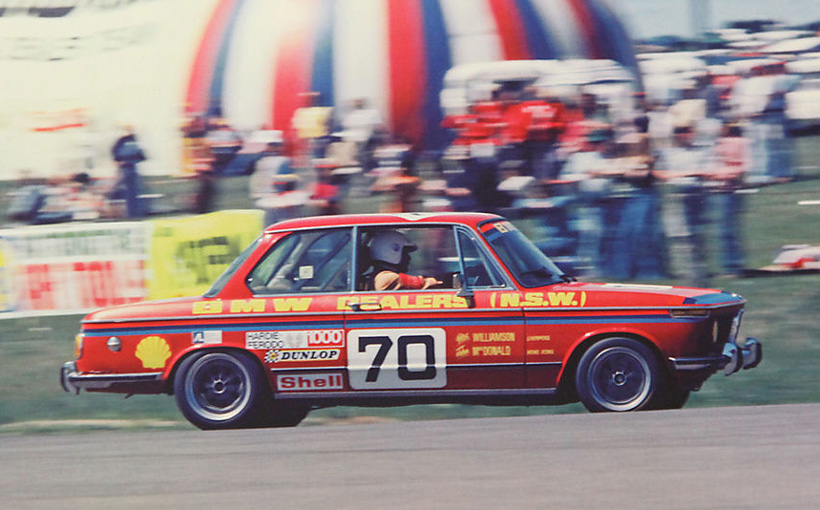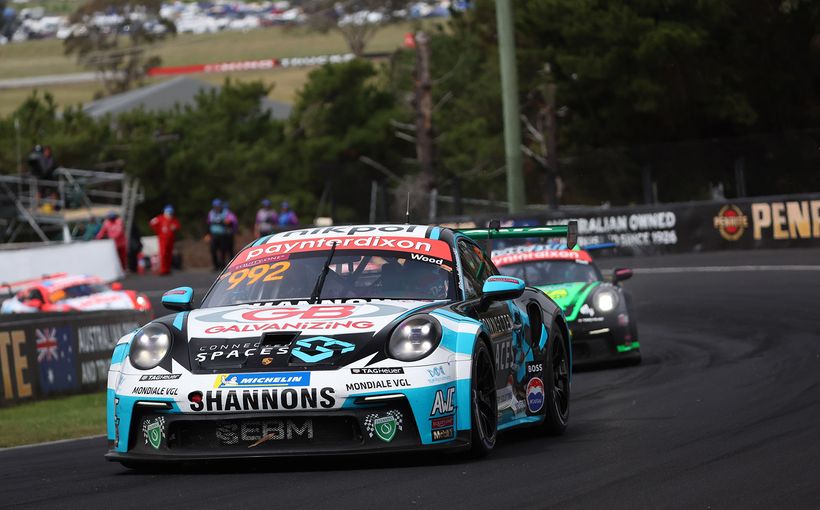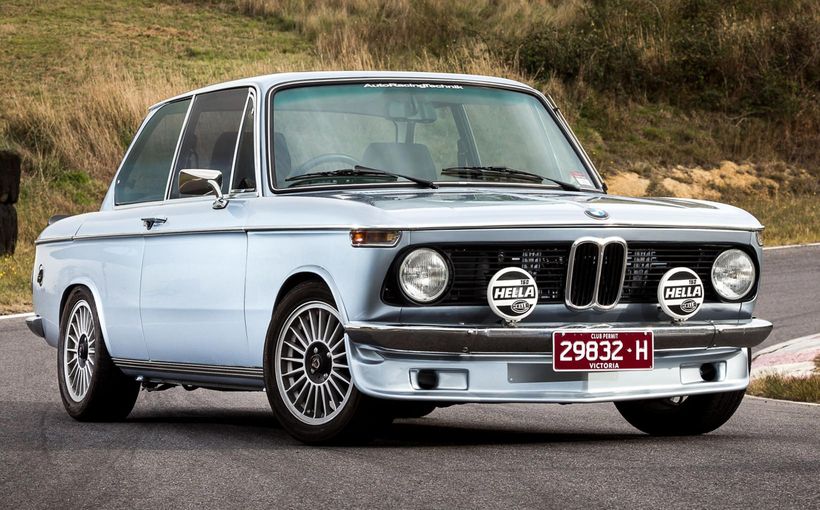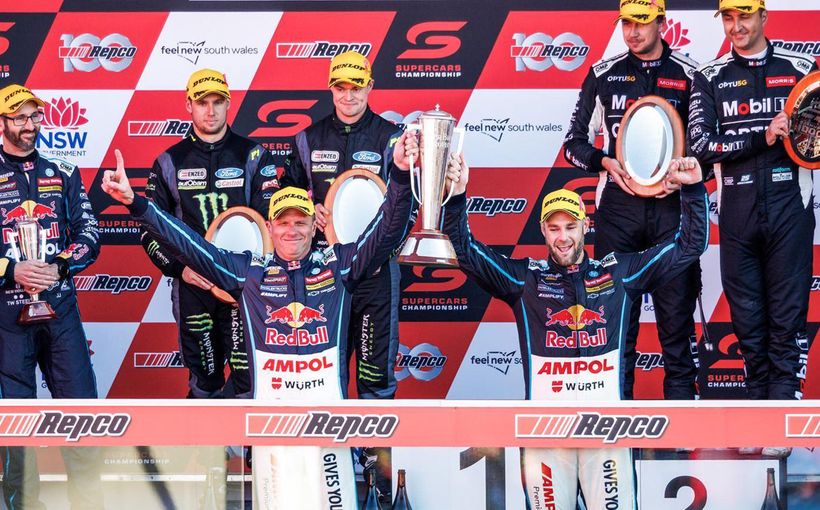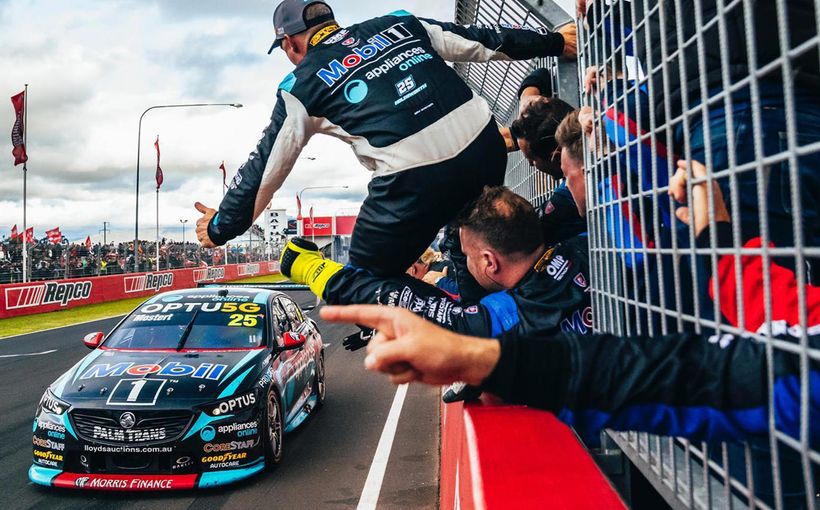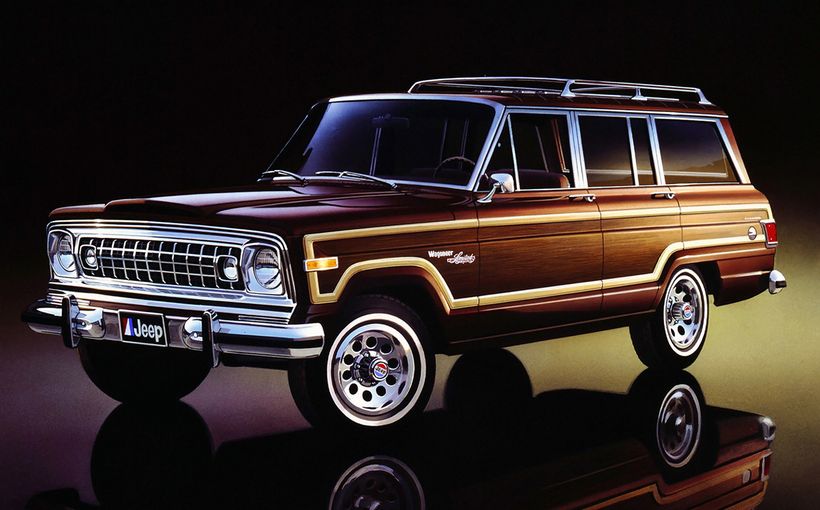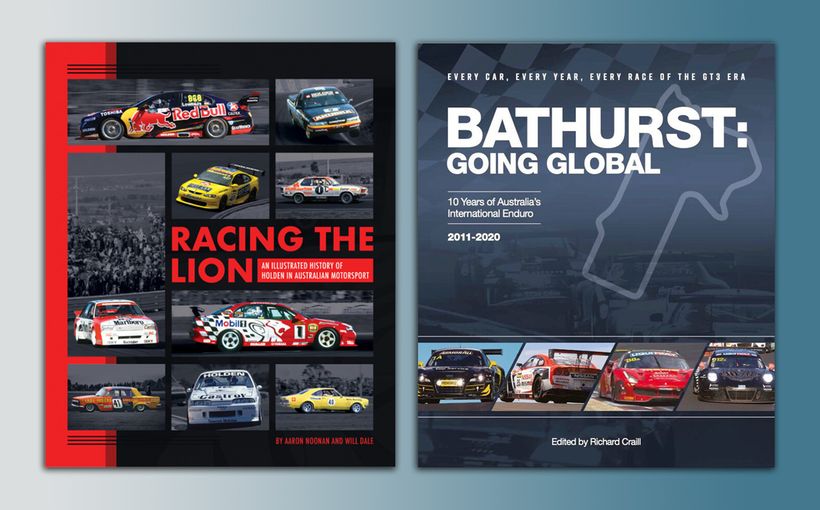BMW 2002: The stunning Bathurst debut that triggered a touring car Blitzkrieg!

The BMW 2002Tii driven by Peter Williamson and John McDonald showed class-winning speed at Bathurst in 1975 and should have won. Here the potent German coupe powers through Hell Corner during its impressive debut performance at the Mountain. Image: www.ebay.com.au
The first appearance of a BMW 2002 in the Bathurst 1000 in 1975, in which a commanding class lead and probable victory was ruined by a simple error in race preparation, sent shockwaves through a quality 2.0 litre class and served notice that the German marque would soon become a major force in local touring car racing.
The fuel injected 2002 Tii (Touring internationale injected) which starred in that dazzling Mountain debut was driven by future Toyota Celica touring car and Racecam star Peter Williamson and Hong Kong-based international racer John McDonald. It was holding a class lead of more than two minutes and on course for a runaway victory, until the engine’s oil pump failed.
However, as Peter Williamson told Shannons Club, the cause of this malfunction had nothing to do with the performance or quality of the oil pump itself; just outside human error that could easily have been avoided.

The BMW 2002 achieved great success in European tin-top racing throughout its seven-year life span, thanks largely to the efforts of various specialised German tuning firms. One of those was GS Tuning established by BMW dealer Gerhard Schneider in 1969, which prepared this rapid 2002 Ti driven with great skill by Dieter Basche to several victories in the 1972 DRM (or German Racing Championship). Image: www.lemans-models.nl
“One of the modifications recommended to us by Alpina (a specialist BMW tuning house in Germany) was to extend the pipe for the oil pump pick-up deeper into the sump (to guard against oil surge),” Williamson said.
“A guy working for me at the time was told to take the oil pump to an excellent fabricator/machinist I knew called Ken Mitchell, to be modified in the way Alpina told us to. However without telling me, my bloke decided to do it himself but used the wrong type of welding rod, which was why the extension pipe for the oil pick-up broke off and wrecked our race. Our car was almost one lap in front and going like a train up until then. It could so easily have won.”
The BMW 2002, following its European release in 1968, proved to be a born athlete in motor sport. With a light kerb weight of less than 1000 kg on a compact 2500mm wheelbase, its MacPherson strut front and coil-sprung semi-trailing arm rear suspension combined with powerful front disc brakes resulted in a robust and well behaved performance platform.

Austrian touring car ace Dieter Quester immediately proved the 2002Ti’s sporting credentials by winning the 1968 European Touring Car Championship for BMW. Quester was a versatile driver who also competed in the Bathurst 1000 on several occasions. Image: www.touringcarracing.net
Under the bonnet beat the willing heart of BMW’s potent 2.0 litre SOHC four cylinder engine, which featured a big breathing crossflow cylinder head with two valves per cylinder operated by stout rocker arms on separate shafts. This ‘slant’ four engine was also tilted 30 degrees for both body styling purposes and to lower the engine’s centre of gravity. It was offered in two specifications, with the hottest twin-carb Ti (Touring internationale) good for 120bhp in stock form mated to a slick-shifting four speed gearbox.
The 2002Ti enjoyed immediate success in European hill-climbs, rallies and circuit racing. Its greatest claim to fame was winning the 1968 European Touring Car Championship (ETCC) for BMW, thanks to a string of class wins by Austrian ace Dieter Quester in the 2.0 litre division. A works-prepared 2002 Ti would also later win the prestigious Nurburgring 24-Hour endurance classic.
The following year (1969) BMW raised the performance level with the 2002 Tii (Touring internationale injected) featuring for the first time Kugelfischer mechanical fuel injection. This development raised the 2.0 litre engine’s output to 130 bhp in stock form, with a whopping 200 bhp potential for motor sport applications on tap using factory upgrades.

The Tii continued the 2002’s success story in 1969, even though Dieter Quester could not repeat the ETCC win enjoyed by its twin-carb predecessor in the 2.0 litre class. That honour went to a factory turbocharged version of the Tii, which was allowed to compete under the ETCC’s liberal Group 5 regulations. Interestingly, in 1973 BMW released a wild 170 bhp road-legal version called the 2002 Turbo, but it was launched during the world’s first energy crisis and few were built.
The 2002 was replaced by the first generation of BMW’s new 3 Series range in 1975. This was the start of a long bloodline of compact models, which would eventually underpin the giant-killing M3 which took international Group A touring car racing and rallying by storm in 1987.

Bathurst & BMW in 1975: A taste of things to come
The sporty BMW 2002 had been seen in Australian motor sport for several years prior to its 1975 Bathurst 1000 debut. The most prominent 2002s back then belonged to BMW enthusiast Paul Older, who competed in both circuit racing (Sports Sedans) and top level rallying during the early 1970s with moderate success.
It was a decision by Sydney car dealer and touring car driver Peter Williamson to take on a BMW franchise that prompted the 2002 Tii’s first appearance at Bathurst in the annual Hardie-Ferodo 1000. His entry was partly supported by funding raised from other NSW dealerships.
Keep in mind the BMW brand in Australia in the mid-1970s was nowhere near the profile or reverence it commands today, even though at the time it was building a great reputation in Europe through its factory-backed touring car programs. Williamson was able to tap directly into that expertise through BMW Motorsport at the company’s head office in Munich and its Alpina race tuning partner.

“I sent a copy of the CAMS manual to a fellow called Jochen Neerpasch (manager) at BMW Motorsport and then flew to Munich to sort out what was needed to suit our (Group C) touring car rules. I was given a very nice reception and shown through BMW Motorsport including all the dyno rooms and future developments they were doing with engines. Everyone was wearing white lab coats and it all looked very professional as you’d expect.
“They had already sent my CAMS manual details to Alpina, so when we drove out there they had all the stuff I needed packed in boxes and neatly stacked up ready to go. And they shipped the lot to Australia for me as part of the deal.
“There were shocks, springs, suspension bushes, injection pumps, camshafts, gear ratios, you name it. They also included a set of lightweight window glass plus a bonnet and boot lid pressed from very thin metal rather than aluminium, because they knew that scrutineers usually carried magnets to check such things!

“Those guys had been racing European Group 1 and Group 2 touring cars for years by then and really knew their stuff. For example, they said if I set up the engine exactly to their specifications it would produce 200 bhp (or 70 bhp more than stock). So when we came home we did just that, paying particular attention to the length of the induction tubes for the fuel injection, which had to measure exactly 12 inches (305mm) from the inlet valve to the end of the induction tube.
“Of course the first time we ran it on Bo Seton’s dyno it pulled exactly 200 horsepower at around 7200 rpm, which was a lot of grunt from a 2.0 litre touring car engine in those days (the top Alfas had about 170 bhp). They used a camshaft made by Schrick in Germany which I later discovered were absolute geniuses. That camshaft alone was one of the key components in finding all that extra power.”
Williamson honed the sporty German two-door into a competitive package during the 1975 season, competing in rounds of the Australian Touring Car Championship, Amaroo Park 3.0 litre touring car series and the BF Goodrich Radial Challenge Series. The latter required all cars to race on the sponsor’s radial road tyres. The little BMW proved to be exceptionally fast, winning the 2.0 litre class and missing the outright series win by one point!

At Bathurst in October, Williamson came within 0.7 sec of stealing the 2.0 litre class pole position from a Ford Escort RS2000 shared by John Bassett and Eric Boord. The BMW was not only quicker than all the other RS2000s, but also a trio of factory-backed Alfa Romeo GTV 2000s featuring a star-studded driver line-up.
Williamson and Bassett hounded each other relentlessly for the first two hours of the race, until a lengthy first pit stop dropped the BMW down the order. By third race distance, though, it had surged back into the lead. By lap 89 of 163 it had the 2.0 litre class shot to bits and looking like a runaway winner until the oil pump-related failure.

Unfulfilled Potential
“We didn’t sell many Tii’s through the dealership because they were bloody dear, but what a good car it was,” Williamson recalled with enthusiasm.
“As a race car it didn’t have any (mechanical) weaknesses. It also didn’t have any vices in terms of handling. If anything, it was too easy to drive. It was one of those cars that could make a good driver look like a great driver because you didn’t have to work too hard to do competitive times.
“You had to be disciplined though and always drive it very straight. You could let a car like my Celica slide a bit in the corners, but with the BMW you had to keep it neat and tidy and just drive it straight. You know, slow in and fast out, but when you got used to that it was easy. It’s probably why it performed so well in the BF Goodrich series, because that style of driving suited those road tyres.”

Given the dazzling speed Williamson’s BMW displayed at Bathurst in 1975, it is perhaps surprising that there wasn’t an influx of 2002Tii’s the following year. However, BMW ceased production of the 2002 series that year, so purchasing a car that was already past its use-by date had little appeal. And with its demise went the latest factory racing developments and components. As a result, the 2002 Tii never nailed the 2.0 litre Bathurst class win it was more than capable of achieving.
Williamson sold his highly developed 2002Tii to part-time racer Ralph Radburn in 1976 and although ‘Willo’ agreed to co-drive at Bathurst as part of the deal, its bad luck continued. This time, although ongoing developments produced a qualifying time almost four seconds faster than the previous year, the Radburn/Williamson car withdraw from the race after only 14 laps due to a broken rocker arm.
Another Tii driven by privateers Peter Granger and Greg Murphy had a troubled run resulting in the car not being classified as a finisher due to an insufficient number of laps being completed.

One of the pre-eminent BMW tuning firms is Schnitzer Motorsport, which over the decades has forged strong ties with the factory and enjoyed tremendous success in tin-top racing. This wild big flared version of the 2002 was built to comply with the FIA’s liberal European Group 5 regulations in the early 1970s. Image: www.bmw2002.co.uk
Granger returned to the Mountain in 1977 with co-driver Ian Richards, but his 2002 Tii was pushed behind the pit wall for good after 96 laps with reportedly a bent valve. The only other Tii in the race shared by sports sedan racers Phil Ward and Phil Lucas, also joined the list of retirements on lap 106 due to engine problems.
It was the third and last time the BMW 2002 would compete in the Bathurst 1000. Without doubt it left the scene with unfulfilled potential, given the exciting developments that emerged four years later when BMW Australia and tobacco giant WD & HO Wills joined forces in an all-out attack on the top level of Aussie touring car racing with the JPS 635 CSi coupe in 1981.
It was the start of a prolonged factory presence by BMW that would span more than a decade and enjoy great success, particularly in the Group A era (1985-1992) when Jim Richards won two Australian Touring Car Championships. The second of those was in the mighty M3 in 1987 - two decades after its famous 2002 ancestor first hit the race tracks of Europe.

"The reason I switched to the twin-cam Toyota Celica in 1977 was because I knew I had a winner in that car"; Williamson reflected. "Given that the 2002 was no longer in production and I was a Toyota dealer with good factory connections, it made sense to go that way at the time.
“Even so, there was a lot of stuff I learned while racing that beaut little BMW that I was able to apply to the Celica over time with great effect. I was just so impressed with that car and the way the BMW and Alpina people went racing, the efficiency, the cleverness in everything they did. It was extraordinary and their success in motor sport has been well deserved.”

